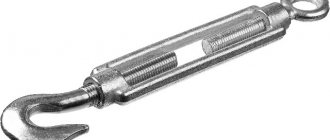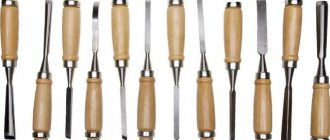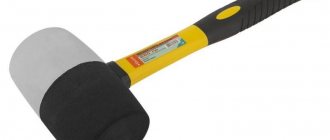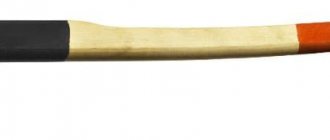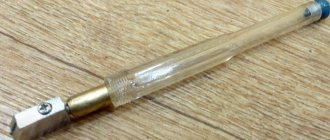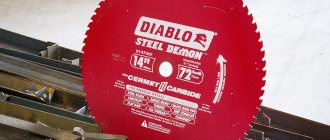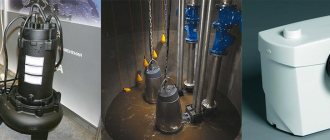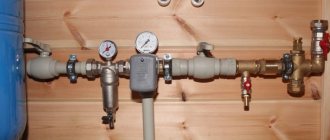Almost any rigging work cannot be done without the use of a special hand-held device called a lanyard.
The system of this tool is extremely simple and reliable, because... provides high strength of connections and ease of use.
This cable tensioner is used where human strength is simply not enough, and the tension is maintained for a long time.
In addition to the construction industry, lanyards are used on ships, when creating cable networks between houses, and even for tensioning ropes in sports rings.
These devices were once used in aviation.
Load capacity, marking and price
The lanyard marking contains a symbol of the type of head, the length of the coupling excluding rings and the thread size indicating which side the left thread is on.
The type of product and its coating are indicated in the accompanying documentation.
As for the load capacity (maximum load), it is sometimes noted in the same documents for the product, depending on the type of load grip and the size of the thread.
You can view the full list using the corresponding table.
As an example:
• M6 – 40 kg for hook, 100 kg for eye;
• M8 - 80 kg and 200 kg respectively;
• M10 - 150 kg and 500 kg.
The cost depends on the size, material, coating, type and other parameters.
For example, the simplest version of the DIN1480 standard with an M6 thread will cost from 70 rubles, while a marine product GOST 9690-71 with an M56 thread will cost about 19 thousand rubles.
The most common tensioners will cost 400 – 1500 rubles.
Important characteristics of lanyards
To ensure that lanyards do not become deformed or destroyed during operation, it is necessary to take a very responsible approach to their selection. In addition, both the dimensions of such devices and the features of their geometric shape should be taken into account so that they are able to perform the tasks assigned to them. There are special tables that every seller should have available: using them, you can compare the marking of the lanyard model with its technical characteristics, size and shape. Both the characteristics, dimensions and type of such devices are specified by a number of international and domestic standards: DIN 1478, DIN 1480, GOST 9690-71, etc.
An important parameter of any device for tensioning steel cables is the thread diameter, and it is not necessary that both screws of such a device will have the same thread. Modern industry produces lanyards with different thread parameters: M5 (“baby”), M8, M10, M12, M16, M20, etc. But you will not find thread parameters in the designation, for example, of a lanyard model T-10-01, T- 30-01, etc. It is very convenient that such marking allows you to accurately determine which load is critical for these devices. It is the first digit in such designations that indicates that the lanyard can withstand a certain level of load, expressed in kN. More detailed information about all the characteristics of a particular model of such a device, including its exact drawing, can be found in the corresponding GOST.
Application of lanyards in production
Most steel braces and, accordingly, devices for tensioning them are used in open air conditions, where they are exposed to the negative effects of high humidity and temperature changes. To eliminate the harmful effects of such factors, lanyards must be reliably protected, which is ensured by their zinc coating or treatment with paints and varnishes. Thanks to such protection methods, such devices can be successfully operated for decades.
How to choose a lanyard?
The most important parameter when choosing a device is its maximum operating load.
Products that are used to secure various units and loads in a vertical position must have a decent margin of 600 - 900%.
Safety is important when working with lanyards.
The determining factor in this matter is how well the rope or cable grips the hook.
The safest are the fork-fork options, where the hook of the sling is covered with a finger made of hardened steel.
Attention!
Options with two hooks are the least safe.
When choosing a lanyard, you should familiarize yourself with its markings, which must strictly be present on the body.
Certified products are usually accompanied by relevant documents.
In addition to the load, the size of the device is an important factor if it is planned to be used in a confined space.
Attention is paid to the presence and degree of anti-corrosion coating.
If products have special operational requirements, they can be equipped with additional devices, for example, a ratchet mechanism.
Before purchasing and using a lanyard, it must be checked for:
• Matching type of thread of the end parts and the body;
• Absence of any damage;
• No wear, any distortions or distortions;
• No cracks, burrs, grooves.
Important!
Make sure that the kit includes lock nuts, which must be used in the work.
Otherwise, the mechanism under load is capable of spontaneously unwinding.
If it is necessary to replace one or both terminal elements, similar options are selected, and their compliance with the applied loads must be checked.
Lanyard from the inside - how it works
Externally, the lanyard resembles a regular coupling, which consists of several screws. The peculiarity is that the screws have threads with the opposite direction. Another important element of any lanyard is the metal base onto which the screws are screwed. As a rule, the base has a cylindrical shape. However, reasons are not always used. Simpler and more primitive models are equipped with special rings. Naturally, the metal base provides greater strength and reliability of the device. In any case, the mechanism works by tightening the screws closer to the center. The result is the maximum tension of cables, ropes, belts or ropes, depending on what exactly is being tightened by the lanyard.
Cargo transportation and rigging are not the only areas where tensioners are used. For example, lanyards can be used in everyday life, in particular, for tuning a piano (tensioning the strings to achieve a better sound), as well as, if necessary, tightening fastenings for curtains.
In most cases, devices for working with cables are made open, that is, the screws for adjusting the tension force are visible. The body can be made by casting, welding or forging. The next stage of the technological process consists of milling two holes, through which the force and length can be changed. Regardless of the production method of each specific part that makes up the tensioner, the device itself is made by turning.
The lanyard consists of two counter-threaded screws and hooks
The design of any lanyard is represented by the following main components:
- Metal body
- Two screws with opposite threads
- The head of a screw, which is made in the form of a ring, hook or fork.
It should be noted that there are also models with closed type screws, which are required to provide additional protection for the goods being transported, since it will take more time to loosen the screws. In addition, closed lanyards are in demand when working with heavy, huge objects in difficult weather conditions.
What you need to know about lanyards?
Lanyards also include the so-called chain ratchets - tensioners, which are used to secure long loads.
The cables are tightened by twisting the tension chain located between the grips.
This device consists of the following elements:
• Cable tensioner (chain);
• Two stoppers;
• Tension mechanism (ratchet wheel mounted on a shaft with a ratchet).
In the simplest ratchet design, the tension slack is taken out not with a ratchet, but with a special lever, which is used to perform rocking movements.
Lanyards - types and applications
Turnbuckles are considered the most important element of rigging devices, with the help of which the individual parts of cargo cables are connected. The types and size range are regulated by GOST 9690, as well as European standards: lanyards DIN 1480 and DIN 1768 are provided. Due to its special importance for the safety of lifting operations, the cargo lanyard must have increased operational reliability.
Ring-ring lanyard (DIN 1480)
Offered product range
The Rusconnect product range includes a wide range of different types of lanyards, which are offered to customers on favorable terms of cooperation. By contacting our online store, the client has the opportunity to order a lanyard, the dimensions of which correspond to the assigned tasks:
- hook-hook - for mounting masts and antennas, convenient to attach to chains and cables with carabiners or rings, also convenient for transporting goods;
- hook-ring - for tensioning or changing the length of cables and chains, for attaching to other rigging elements;
- ring-ring - for securing oversized cargo, you can attach hooks, carabiners to them, tie ropes or thread them.
It is important to consider how the lanyard works, its purpose and use in certain situations.
Tubular lanyard (closed) DIN 1478 U+U RUB 261.73 / PC.
Lanyard Housing DIN 1478 RUR 61.85 / PC.
Tubular lanyard (closed) DIN 1478 I+I RUB 88.34 / PC.
Lanyard hook-hook C+C GreenLane RUR 23.47 / PC.
Lanyard ring-ring O+O GreenLane RUB 23.47 / PC.
Main dimensions of lanyards, mm
| Permissible load , kN | Thread lanyard | Turnbuckle stroke L-L1 | Execution | |||||||||||
| BB | UU | GT | VU | VG | GU | |||||||||
| L | L1 | L | L1 | L | L1 | L | L1 | L | L1 | L | L1 | |||
| 0,98 | M6 | 75 | 230 | 155 | 244 | 169 | 236 | 161 | 237 | 162 | 233 | 158 | 240 | 165 |
| 1.96 | M8 | 112 | 324 | 212 | 344 | 232 | 360 | 248 | 334 | 222 | 342 | 230 | 352 | 240 |
| 2,94 | M10 | 112 | 341 | 229 | 365 | 253 | 383 | 271 | 353 | 241 | 362 | 250 | 374 | 262 |
| 4,9 | M12 | 140 | 421 | 281 | 449 | 309 | 461 | 321 | 435 | 295 | 441 | 301 | 455 | 315 |
| 7,84 | M14 | 140 | 434 | 294 | 466 | 326 | 472 | 332 | 450 | 310 | 453 | 313 | 469 | 329 |
| 11,76 | M16 | 168 | 524 | 356 | 558 | 390 | 558 | 390 | 541 | 373 | 541 | 373 | 558 | 390 |
| 15.68 | M18 | 168 | 542 | 374 | 582 | 414 | — | — | 562 | 394 | — | — | — | — |
| 19,6 | M20 | 185 | 603 | 418 | 653 | 468 | — | — | 628 | 443 | — | — | — | — |
| 24,5 | M22 | 185 | 629 | 444 | 681 | 496 | — | — | 655 | 470 | — | — | — | — |
| 31,6 | M24 | 212 | 719 | 507 | 787 | 575 | — | — | 753 | 541 | — | — | — | — |
| 39,2 | M27 | 212 | 757 | 545 | 821 | 609 | — | — | 789 | 577 | — | — | — | — |
| 49 | M33 | 248 | 881 | 633 | 949 | 701 | — | — | 915 | 667 | — | — | — | — |
| 61,74 | M36 | 248 | 900 | 652 | 976 | 728 | — | — | 938 | 690 | — | — | — | — |
| 78,4 | M39 | 265 | 987 | 722 | 1083 | 818 | — | — | 1035 | 770 | — | — | — | — |
| 98 | M42 | 265 | 1027 | 762 | 1121 | 856 | — | — | 1074 | 809 | — | — | — | — |
| 122,5 | M48 | 290 | 1133 | 843 | 1231 | 941 | — | — | 1182 | 892 | — | — | — | — |
| 156,8 | M52 | 290 | 1159 | 869 | 1261 | 971 | — | — | 1210 | 920 | — | — | — | — |
| 196 | M56 | 308 | 1247 | 939 | 1391 | 1083 | — | — | 1319 | 1011 | — | — | — | — |
Lanyards
VRH in a closed housing.
| Size | Working load, tons | Breaking force, tn | A, mm | B, mm | C, mm | D, mm | Case length, mm | Weight, kg |
| M6 | 0,2 | 1 | 9 | 18,5 | 4,8 | 175 — 237 | 103 | 0,15 |
| M8 | 0,3 | 1,5 | 9 | 18 | 5,9 | 200 — 290 | 128 | 0,3 |
| M10 | 0,5 | 2,5 | 11,2 | 18,2 | 8 | 235 — 350 | 152 | 0,5 |
| M12 | 0,7 | 3,5 | 18,8 | 30 | 9,5 | 357 — 530 | 237 | 1 |
| M16 | 1,2 | 6 | 19 | 45 | 11,2 | 405 — 540 | 230 | 1,4 |
| M20 | 1,5 | 7,5 | 21 | 39 | 16 | 400 — 548 | 230 | 2,2 |
| M22 | 2,2 | 11 | 23,5 | 39 | 18,6 | 460 — 700 | 305 | 3 |
| M24 | 5 | 25 | 32 | 51,5 | 22 | 575 — 820 | 360 | 4,7 |
| M33 | 7 | 35 | 37 | 64 | 24 | 655 — 920 | 380 | 8,1 |
| M39 | 10 | 50 | 46 | 73,5 | 32 | 715 — 990 | 470 | 11,9 |
| M45 | 13 | 65 | 50,5 | 89 | 36,5 | 775 — 970 | 415 | 18,6 |
| M50 | 17 | 85 | 51,4 | 96 | 43 | 805 — 980 | 413 | 22,6 |
Rigging lanyards
in an open case
| Size metric | Size in inches | Breaking load, tons | Length min/max in mm. | Weight/piece, kg. |
| M6 | 1/4x4 | 0,23 | 200/320 | 0,16 |
| M8 | 5/16x4 | 0,36 | 238/353 | 0,25 |
| M10 | 3/8x6 | 0,54 | 289/441 | 0,37 |
| M12 | 1/2x6 | 0,98 | 330/508 | 0,71 |
| M12 | 1/2x9 | 0,98 | 406/660 | 0,79 |
| M12 | 1/2x9 | 0,98 | 406/660 | 0,79 |
| M12 | 1/2x12 | 0,98 | 482/812 | 1,09 |
| M16 | 5/8x6 | 1,6 | 377/562 | 1,23 |
| M16 | 5/8x9 | 1,6 | 454/714 | 1,56 |
| M16 | 5/8x12 | 1,6 | 530/866 | 1,77 |
| M19 | 3/4x6 | 2,35 | 421/612 | 1,86 |
| M19 | 3/4x9 | 2,35 | 497/764 | 2,48 |
| M19 | 3/4x12 | 2,35 | 574/916 | 2,92 |
| M19 | 3/4x18 | 2,35 | 726/1221 | 3,66 |
| M22 | 7/8x12 | 3,27 | 617/966 | 3,71 |
| M22 | 7/8x18 | 3,27 | 770/1271 | 4,89 |
| M26 | 1x12 | 4,5 | 661/1017 | 5,68 |
| M26 | 1x18 | 4,5 | 814/1322 | 6,87 |
| M26 | 1x24 | 4,5 | 966/1627 | 8,2 |
| M32 | 1 1/4x12 | 6,84 | 750/1118 | 9,34 |
| M32 | 1 1/4x18 | 6,84 | 902/1423 | 11,19 |
| M32 | 1 1/4x24 | 6,84 | 1055/1728 | 12,79 |
| M40 | 1 1/2x12 | 9,7 | 800/1181 | 13,92 |
| M40 | 1 1/2x18 | 9,7 | 952/1485 | 16,67 |
| M40 | 1 1/2x24 | 9,7 | 1104/1790 | 18,45 |
Lanyards DIN 1480
rigging in an open housing.
The practical use of lanyards largely depends on their design. The maximum level of reliability of guy ropes and other elements of cargo equipment is provided by the fork-fork lanyard.
For non-essential operations and household needs the following is used:
ring-ring lanyard
lanyard “hook-ring”
hook-and-hook lanyard
It should be remembered that for the last two, the breaking load of the hook is significantly lower than the ring and body.
| Standard size | Length min/max in mm. | Breaking load, tons | Weight 100 pcs., kg. | |||||
| lanyard hook-ring | lanyard ring-ring | lanyard hook-hook | FRAME | RING | HOOK | lanyard hook-ring | lanyard ring-ring, lanyard hook-hook | |
| M6 | 172/252 | 167/247 | 180/260 | 1 | 0,1 | 0,04 | 9,5 | 9 |
| M8 | 182/257 | 179/254 | 195/270 | 1,2 | 0,2 | 0,08 | 16,5 | 15,5 |
| M10 | 213/298 | 210/295 | 230/315 | 1,5 | 0,5 | 0,15 | 29 | 27 |
| M12 | 238/318 | 230/310 | 250/330 | 2 | 2 | 0,35 | 43 | 41 |
| M14 | 263/353 | 250/340 | 280/370 | 2 | 2 | 0,35 | 62 | 60 |
| M16 | 320/430 | 330/440 | 320/430 | 3 | 3 | 0,7 | 92 | 100 |
| M20 | 367/497 | 335/465 | 400/530 | 4 | 4 | 1 | 163 | 154 |
| M22 | 398/543 | 268/513 | 428/573 | 5 | 5 | 1,5 | 220 | 200 |
| M24 | 447/617 | 420/590 | 490/660 | 6 | 6 | 2 | 300 | 270 |
| M30 | 512/662 | 510/670 | 530/690 | 8 | 10 | 3 | 460 | 435 |
